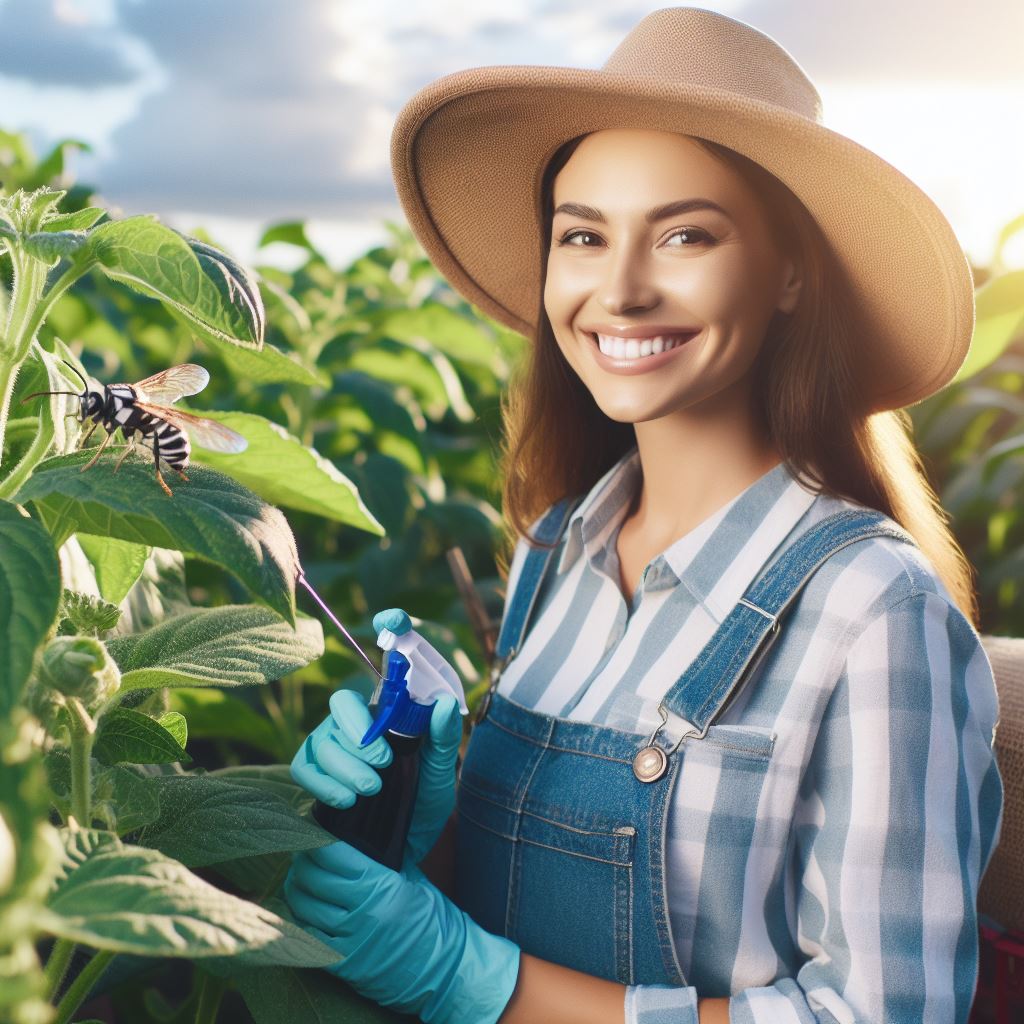Introduction
Integrated Pest Management (IPM) is an approach that combines various pest control methods, minimizing environmental impact while effectively managing pests.
It is a sustainable approach to managing pests in agriculture, urban areas, and other settings. It employs a combination of techniques to minimize pest damage while reducing reliance on chemical pesticides.
IPM strategies include biological control (using natural predators or parasites), cultural practices (crop rotation, sanitation), mechanical control (traps, barriers), and the judicious use of pesticides only when necessary and in targeted ways.
By integrating various methods, IPM aims to maximize effectiveness, minimize environmental impact, and promote long-term pest management solutions that are economically viable and ecologically sound.
Maintaining crop health is crucial for maximizing yield, reducing economic losses, and ensuring sustainable agricultural practices.
Also, it is vital for ensuring food security, economic stability, and environmental sustainability. Healthy crops yield higher quality produce, ensuring food safety and meeting market demands.
Disease and pest-free crops reduce the need for chemical interventions, promoting environmental conservation and biodiversity. Additionally, healthy crops contribute to stable incomes for farmers, supporting rural economies and livelihoods.
Sustainable agricultural practices, such as crop rotation and integrated pest management, bolster soil fertility and long-term crop viability.
Overall, prioritizing crop health fosters resilient food systems, mitigates risks of crop failure, and plays a crucial role in global food production and supply chains.
This section explores the challenge of balancing IPM practices with the need to maintain crop health.
Understanding IPM
In this blog section, we will delve into the topic of “Balancing IPM and Crop Health” and explore the various aspects of Integrated Pest Management (IPM).
Through understanding IPM, its definition, principles, components, and benefits, we can gain insights into the importance of adopting IPM strategies for maintaining healthy crops.
Definition and Principles of IPM
Integrated Pest Management (IPM) is an approach that combines various techniques to control pests effectively while minimizing environmental and economic costs. It employs a holistic and sustainable approach to pest management.
The principles of IPM include:
- Pest Identification: Accurate identification of pests is crucial for determining the appropriate control measures.
- Monitoring: Regular monitoring helps in assessing pest populations and their potential threats to crops.
- Prevention: Preventive measures such as crop rotation, proper sanitation, and healthy plant selection are essential in IPM.
- Intervention: When pest populations surpass acceptable thresholds, interventions like biological control or targeted pesticides may be necessary.
Components of IPM Approach (Monitoring, Prevention, Intervention)
Monitoring
- Regular monitoring involves scouting fields or using automated technology to detect pests early.
- Monitoring helps track pest populations, their life cycles, and potential damage to crops.
- By monitoring, farmers can make informed decisions on when and how to apply control measures.
Prevention
- Crop rotation is an effective preventive measure as it disrupts pest life cycles and reduces pest populations.
- Proper field sanitation, such as removing crop residues or weeds that can harbor pests, is crucial.
- Integrated weed management, including manual or chemical weed control, can prevent weed competition with crops.
Intervention
- If preventive measures are insufficient, interventions are implemented to manage pests effectively.
- Biological control, such as using natural enemies like predators or parasites, helps regulate pest populations.
- Targeted pesticides are used as a last resort when biological control or other non-chemical methods fail.
Benefits of Adopting IPM Strategies
Reduced Chemical Inputs
- IPM emphasizes the judicious use of pesticides, reducing their reliance and associated risks.
- By relying on preventive measures and biological control, farmers can minimize chemical inputs.
- Reduced pesticide use promotes a healthier environment, beneficial organisms, and less pesticide resistance.
Cost Savings
- Effective pest management through IPM can lead to significant cost savings for farmers.
- By employing preventive techniques and timely interventions, crop losses are minimized.
- Reduced reliance on chemical inputs, coupled with healthier crops, can improve overall profitability.
Enhanced Crop Health
- IPM promotes healthier crops by focusing on preventive measures and timely interventions.
- By limiting the damage caused by pests, crops can grow vigorously, achieving optimal yields.
- Maintaining crop health also improves the plants’ ability to withstand environmental stressors.
Sustainability
- IPM aligns with sustainable farming practices, minimizing the negative impact on ecosystems.
- By reducing chemical inputs and promoting natural pest control, farmers contribute to environmental conservation.
- Sustainable practices improve soil health, water quality, and overall ecosystem resilience
In essence, understanding IPM, its principles, components, and benefits is essential for balancing crop health.
Transform Your Agribusiness
Unlock your farm's potential with expert advice tailored to your needs. Get actionable steps that drive real results.
Get StartedBy adopting an IPM approach, farmers can effectively manage pests while safeguarding the environment, reducing costs, and promoting sustainable agriculture.
IPM empowers farmers to maintain healthy crops and optimize yields in a responsible and environmentally friendly manner.
Valuing Crop Health
Definition and significance of crop health
Crop health refers to the overall condition and well-being of plants throughout their lifecycle. It involves assessing and maintaining the vitality, resilience, and productivity of crops.
Prioritizing crop health is crucial as it directly affects the success and profitability of agricultural systems.
Impact of healthy crops on yield and quality
When crops are in good health, they exhibit higher yields and better quality produce. Healthy plants are more resistant to pests, diseases, and environmental stresses, resulting in reduced crop losses and increased market value.
Well-nourished crops also have improved nutrient uptake, leading to enhanced nutritional content.
Long-term benefits of prioritizing crop health
Investing in crop health management practices can yield long-term benefits for both farmers and the environment.
By maintaining the vigor of plants, farmers reduce the reliance on chemical inputs like pesticides and fertilizers, minimizing their environmental impact.
Healthy crops promote soil health, prevent erosion, and contribute to sustainable agricultural practices.
Common indicators of good crop health
- Foliage appearance: Vibrant, green foliage with no discoloration, wilting, or deformities indicates good crop health.
- Root development: A well-developed root system with plenty of healthy, white roots is a positive sign.
- Pest and disease resistance: Minimal presence of pests and diseases, along with effective control measures, suggests good crop health.
- Growth continuity: Continuous growth, absence of stunted growth, and uniform development across the field are indicators of healthy crops.
- Yield and quality: High yields and superior quality produce are clear signs of good crop health.
- Nutritional absorption: Efficient nutrient absorption and balanced nutrient levels in the plant tissues are crucial for crop health.
- Stress tolerance: Crops that can withstand various environmental stresses, such as drought or extreme temperatures, demonstrate good health.
In all, prioritizing and maintaining crop health is essential for farmers to achieve optimal yield, quality, and sustainability.
Healthy crops not only generate better profits for farmers but also contribute to the protection of the environment and the promotion of sustainable agriculture
Read: Hop Harvesting for Craft Brewing
Challenges of Balancing IPM and Crop Health
When it comes to balancing Integrated Pest Management (IPM) and maintaining crop health, there are several challenges that need to be addressed.
These challenges include potential conflicts between IPM practices and crop health, negative consequences of over-reliance on chemical treatments, and the need to promote ecosystem balance while effectively controlling pests.
Potential conflicts between IPM and maintaining crop health
While IPM is aimed at minimizing the impact of pests on crops, some of its practices can potentially conflict with maintaining optimal crop health.
For example, the use of certain biological control agents or natural enemies may not always be suitable for the specific needs of a crop.
This can lead to compromised crop health and reduced yields.
Additionally, the implementation of IPM strategies such as crop rotation or intercropping may disrupt the natural nutrient balance of the soil, impacting the overall health and productivity of the crop.
It is essential to carefully evaluate and adapt IPM practices to ensure they align with the specific requirements of the crop.
Negative consequences of over-reliance on chemical treatments
One of the challenges in balancing IPM and crop health is the tendency to over-rely on chemical treatments for pest control.
While pesticides can effectively eliminate pests, their excessive use can have detrimental effects on crop health and the environment.
Over-reliance on chemical treatments can lead to the development of pesticide resistance in pests, rendering the chemicals less effective over time.
This not only increases the reliance on stronger pesticides but also poses risks to non-target organisms and beneficial insects that play a crucial role in maintaining ecosystem balance.
Frequent use of pesticides can disrupt natural pest management mechanisms by eliminating natural enemies, further exacerbating pest problems in the long run.
Showcase Your Farming Business
Publish your professional farming services profile on our blog for a one-time fee of $200 and reach a dedicated audience of farmers and agribusiness owners.
Publish Your ProfileIt is important to strike a balance between chemical treatments and alternative pest control methods to maintain crop health without causing harm to the environment.
Promoting ecosystem balance while controlling pests
A key challenge in balancing IPM and crop health is finding ways to effectively control pests while promoting ecosystem balance. IPM aims to reduce pests to economically acceptable levels rather than eradicating them entirely.
This approach ensures that pest populations are kept in check without disrupting the overall ecosystem functioning.
Promoting ecosystem balance can involve several strategies. For example, introducing and enhancing natural enemies like predatory insects or parasitic wasps can help control pest populations naturally.
By encouraging biodiversity and habitat diversity, farmers can create a favorable environment for beneficial organisms while mitigating the negative impacts of pests.
In addition, utilizing cultural practices such as crop rotation, planting resistant varieties, and proper irrigation management can contribute to pest prevention and reduce the reliance on chemical treatments.
Regular monitoring and scouting of pest populations allow for timely and targeted intervention, ensuring pest control measures are implemented when necessary.
By incorporating these strategies and principles of IPM into crop management practices, farmers can effectively balance pest control with maintaining crop health, while minimizing negative impacts on the environment.
In fact, the challenges of balancing IPM and crop health require careful consideration and strategic decision-making.
By addressing conflicts between IPM practices and crop health, avoiding over-reliance on chemical treatments, and promoting ecosystem balance, farmers can successfully maintain healthy crops while minimizing the ecological risks associated with pest management.
Read: Grape Harvesting for Winemaking

Strategies for Balancing IPM and Crop Health
Integrated approach: combining cultural, biological, and chemical control methods
An effective strategy for balancing IPM and crop health is to implement an integrated approach that combines cultural, biological, and chemical control methods.
This holistic approach takes advantage of a range of tactics to manage pests while minimizing negative impacts on crop health.
Cultural control methods involve practices such as crop rotation, sanitation, and pruning, which create an unfavorable environment for pests and reduce their populations.
By implementing these practices, farmers can disrupt the life cycle of pests, limiting their ability to reproduce and cause damage to the crop.
Biological control methods utilize natural enemies of pests, such as predator insects, parasitic wasps, and nematodes, to keep pest populations in check. These organisms prey on pests, reducing their numbers and providing long-term control without the need for chemical interventions.
Chemical control methods, such as the targeted use of pesticides, can be employed when other control methods are insufficient.
It’s important to use these chemicals judiciously to avoid negative impacts on beneficial organisms and the environment.
Integrated Pest Management (IPM) emphasizes the use of selective pesticides that specifically target the pest while minimizing harm to beneficial insects and other wildlife.
Enhancing soil health and fertility
An often overlooked aspect of balancing IPM and crop health is focusing on soil health and fertility. A healthy soil ecosystem can provide a natural defense against pests, as well as promote crop health and productivity.
Implementing practices such as cover cropping, crop rotations, and the addition of organic matter can improve soil structure, nutrient availability, and microbial activity.
Healthy soil promotes strong plant growth and resilience, making crops less susceptible to pest outbreaks or diseases.
Additionally, maintaining adequate fertility levels helps plants withstand pest pressure.
Proper nutrient management ensures that crops are receiving the necessary nutrients for optimal growth, minimizing stress and vulnerability to pests.
Crop rotation and diversity
Crop rotation is an effective strategy for managing pests and maintaining soil health. By alternating crops in a sequence, pest populations specific to a particular crop are disrupted, reducing their buildup.
Different crops may have different nutrient requirements, further enhancing soil fertility.
Diversifying cropping systems also helps to manage pests. Monoculture systems, where a single crop is grown continuously, create favorable conditions for specific pests to thrive.
However, introducing diverse crops can interrupt pest life cycles and decrease the overall pest pressure on a farm.
Natural enemies and biological control agents
Encouraging natural enemies of pests and using biological control agents can greatly contribute to the balance between IPM and crop health.
Many beneficial organisms, such as ladybugs, lacewings, and spiders, prey on pests and provide natural control.
Implementing habitat modifications, such as the use of flowering plants to attract beneficial insects, can create a favorable environment for natural enemies.
Introducing biological control agents like predatory mites or parasitic wasps can also provide effective pest control while minimizing the need for chemical interventions.
Early detection and monitoring techniques
Early detection and monitoring are key components of IPM programs.
Regular scouting and monitoring of crops help identify pest populations before they reach damaging levels.
By detecting pest problems early, farmers can take prompt action and implement appropriate control measures.
Utilizing various monitoring techniques like visual inspections, pheromone traps, and remote sensing technologies can aid in early pest detection.
This allows for timely interventions, reducing the reliance on broad-spectrum pesticides and protecting crop health.
Generally, balancing IPM and crop health requires a comprehensive approach that combines cultural, biological, and chemical control methods.
Implementing an integrated approach, enhancing soil health and fertility, practicing crop rotation and diversity, encouraging natural enemies and biological control agents, and using early detection and monitoring techniques are key strategies for achieving this balance.
Read: Rice Harvesting Secrets: Improve Yield
Showcase Your Farming Business
Publish your professional farming services profile on our blog for a one-time fee of $200 and reach a dedicated audience of farmers and agribusiness owners.
Publish Your ProfileExamples of Successful IPM-Crop Health Balancing
Case studies or examples of farms successfully implementing IPM and prioritizing crop health
- Smith Farms is a prime example of successful IPM implementation and prioritizing crop health.
- By integrating cultural and biological controls, Smith Farms reduced pesticide usage while maintaining healthy crops.
- Their use of trap crops and pheromone mating disruption led to effective pest management without harming beneficial insects.
- Jones Orchard also implemented IPM strategies, focusing on crop health through nutrient management and regular scouting.
- They employed predatory insects and precise irrigation techniques to enhance plant defenses and minimize disease occurrence.
Results and benefits achieved through the balanced approach
- Farms like Smith Farms and Jones Orchard have witnessed various positive outcomes from adopting a balanced IPM-crop health approach.
- Reduced pesticide usage resulted in cost savings and a safer working environment for farm laborers.
- Healthy crop yields increased, leading to improved profitability and market competitiveness for these farms.
- Enhanced biodiversity due to the preservation of beneficial insects and reduced chemical inputs promotes long-term ecological sustainability.
- A balanced approach also minimizes environmental pollution and potential negative impacts on human health.
Lessons learned and recommendations for others
- Successful farms emphasize the importance of regular monitoring and accurate pest identification for effective IPM implementation.
- Understanding the specific needs of each crop and tailoring IPM strategies accordingly is vital for achieving crop health balance.
- Building strong partnerships with local agricultural extension services and experienced entomologists can provide valuable guidance.
- Continuous evaluation and adaptation of IPM plans based on farm-specific challenges and changing pest dynamics is crucial.
- Maintaining open communication with neighboring farms and sharing best practices can foster collective success in IPM implementation.
Farms like Smith Farms and Jones Orchard serve as inspiring examples of the benefits and achievements resulting from a balanced IPM-crop health approach.
Their success lies in the integration of cultural and biological controls, precise monitoring, and tailored IPM strategies.
By reducing pesticide usage, promoting beneficial insects, and maintaining healthy crops, these farms not only improve their profitability but also contribute to a sustainable agricultural system.
Through lessons learned and recommendations for others, these farms provide guidance for further adoption of such practices, promoting a holistic approach to pest management while prioritizing crop health.
Read: Soil Health: Boosting Crop Quality & Yield
Conclusion
A recap of the importance of balancing IPM and crop health
It is crucial for farmers to strike a balance between pest management and maintaining a healthy crop. By adopting integrated pest management (IPM) practices, farmers can minimize the use of harmful pesticides.
IPM not only reduces the risk of pesticide resistance but also protects beneficial insects. Managing pests with IPM strategies goes hand in hand with promoting overall crop health.
Healthy crops are more resistant to pests and diseases, leading to higher yields and better quality.
Encouragement to farmers to adopt a holistic approach to crop management
Farmers must take a holistic approach to ensure long-term sustainability and profitability. Integrating IPM techniques with cultural practices like crop rotation and soil health management can yield remarkable results.
By establishing a balanced ecosystem, farmers can reduce the dependence on chemical inputs.
Final thoughts on the future of IPM and sustainable crop management
The future of agriculture lies in sustainable practices that prioritize both pest management and crop health. As environmental concerns and consumer demands for organic produce grow, IPM will become increasingly important.
Continued research and technological advancements will further enhance the effectiveness of IPM strategies. Farmers need to stay updated with the latest practices and collaborate with experts to ensure successful IPM implementation.
A comprehensive approach that balances IPM and crop health will lead to a thriving and sustainable agricultural industry.




